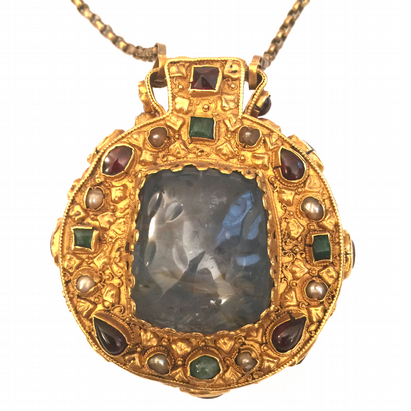
Identifier les gemmes du Talisman de Charlemagne
Identifying the gems of the Talisman of Charlemagne
Gérard Panczer (équipe SOPRANO), en collaboration avec des collègues de Lyon et de Bâle, a publié un article intitulé "The Talisman of Charlemagne: new historical and gemological discoveries" dans la revue Gems&Gemology.
Gérard Panczer (SOPRANO team), with colleagues from Lyon and Basel, published an article entitled "The Talisman of Charlemagne: new historical and gemological discoveries" in the journal Gems&Gemology.
Au cours de cette étude, ont été menées pour la première fois des analyses non destructives, combinées, par spectrométries Raman, de photoluminescence, d’absorption optique et de fluorescence X du Talisman dit de Charlemagne sur le site du Musée du Tau à Reims. Ce reliquaire du 9ème siècle, présente 29 pierres gemmes de couleurs et 22 perles fines.
La spectrométrie Raman a permis d’identifier avec certitude la nature des gemmes (saphirs, émeraudes, grenats, améthystes, verre). L’analyse combinée par absorption optique et photoluminescence a permis de déterminer les éléments chromogènes. La quantification des éléments traces par fluorescence X a permis d’émettre des hypothèses argumentées quant à leurs origines géographiques.
La spectrométrie Raman a permis d’identifier avec certitude la nature des gemmes (saphirs, émeraudes, grenats, améthystes, verre). L’analyse combinée par absorption optique et photoluminescence a permis de déterminer les éléments chromogènes. La quantification des éléments traces par fluorescence X a permis d’émettre des hypothèses argumentées quant à leurs origines géographiques.
During this study, combined non-destructive analyzes by Raman spectroscopy, photoluminescence, optical absorption and X-ray fluorescence were conducted for the first time on the so-called Talisman of Charlemagne at the Tau Museum in Reims. This reliquary of the 9th century, presents 29 color gemstones and 22 fine pearls.
Raman spectrometry has made it possible to identify with certainty the nature of the gems (sapphires, emeralds, garnets, amethysts, glass). The combined analysis by optical absorption and photoluminescence made it possible to determine the chromogen elements. The quantification of the trace elements by X-ray fluorescence made it possible to make well-founded hypotheses concerning their geographical origins.
Raman spectrometry has made it possible to identify with certainty the nature of the gems (sapphires, emeralds, garnets, amethysts, glass). The combined analysis by optical absorption and photoluminescence made it possible to determine the chromogen elements. The quantification of the trace elements by X-ray fluorescence made it possible to make well-founded hypotheses concerning their geographical origins.


















